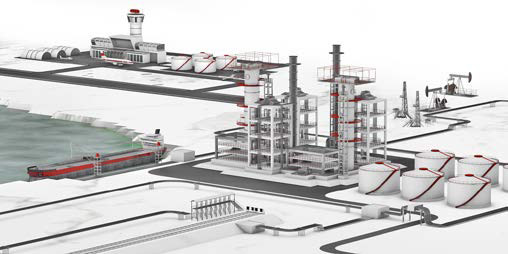
Relevant for: Engineering companies, metering solution providers, pipeline operators, tank farm operators and oil and gas companies
Transportation, refining and distribution of hydrocarbons are extensive operations in the downstream section of petroleum industries. The products pass through a lot of stages during and after the refining process. To continuously monitor your products’ characteristics and to optimize your process at every stage, Anton Paar provides several solutions for density measurement.

Introduction
Petroleum is a major product that is heavily used as fuel in transportation, feedstock for chemical manufacturing and for various materials, and most importantly as a major utility heating fuel by many people across the world. The petroleum industry from the exploration to the final product is usually divided into three major segments. The upstream segment includes the exploration of potential oil or gas fields, the exploitation of this field (drilling the wells) and the production (bring the raw crude or gas to the surface). The midstream segment includes the field processing steps like separating the raw crude into crude oil, gas, water and impurities, the temporary storage and transportation to the refinery. The downstream segment includes the refining of the crude oil including all required production steps to get the final product and the distribution of the final products. Especially in the downstream section accurate measurements of the final properties are required.
Volume to mass
Mass is one of the fundamental units for trading liquids. It is regardless of local gravity, pressure and temperature. Nevertheless, most petroleum industries are equipped with volume meters which can be upgraded for mass calculations. The volume of a substance is directly related to its density which is highly dependent on the temperature of the liquid. Variations of the product density have great influence on the calculation of the mass of a product. If the actual density of the product is not considered in the calculation, the operator of a tank farm is – besides loss of profit – also confronted with legal regulations against black marketing where deviations in the mass balance of tank farms have to be kept below a certain limit. In addition, the density is one of the most important quality parameters. A continuous density measurement ensures the quality of the incoming and outgoing product and documents the quality of the product. The combination of a highly accurate inline density meter and a volume flow meter assures an optimum mass balance determination, required for tight financial control of custody transfer points. The combination of density and volume measurement is a good alternative to direct mass flow measurement because of competitive pricing, higher density accuracy and lower integration effort as well as the possibility to upgrade existing flow meters.
Applications
Airplane fuelling
Aircraft fuels are typically supplied from over- or underground storage tanks located at the airports. Large airplanes get their aviation fuel via an underground pipeline system direct to the parking position. So-called hydrant dispenser, dispenses the fuel from this underground hydrant system to the underwing nozzle of the airplane. The dispenser itself has no tank to store the fuel. Smaller aircrafts get their aviation fuel via aviation refuellers. These are trucks equipped with tank, pump, filters and a metering system. Fuelling is possible through the over- and underwing nozzles. To optimize the fuelling process, the mass of the filled-up fuel has to be determined online. The knowledge of the exact mass enables the reduction of excess fuel charge which prevents aircraft from over fuelling. For this purpose the density value has to be combined with the filling volume measured by the volumetric measuring system. Furthermore, the CO2 emission tax can be reduced by its accurate density measurement. If the density of the fuel is unknown a fixed value 0.8 g/cm³ is taken into account to calculate the CO2 tax. Normally, the density of the fuel is below 0.8 g/cm³ which reduce the cost significantly. Additionally, a highly accurate density measurement guarantees a continuous quality control.
Tank farm and Pipelines
In the downstream segment many transfer steps are necessary between the different stages and deliveries. We are talking about custody transfer measurement if the product is transferred from one owner to another. The owner can be an oil production company, a pipeline company, a refinery or many others. Because of the huge amount of product which is transferred between parties, a small measuring error causes a major financial loss. Often the transfer is monitored by volume flow meters and additional mass calculation for a tight financial control. For the calculation from volume to mass a high accurate density measurement is required to reduce the risk of a financial loss. The financial loss is a linear function of the error of the density measurement! A tenth percentage error of the density measurement will be a tenth percentage of deviation in the accounting. Because of the huge amount of product this can be a huge amount of money.
Process Solution – Inline density meter

Figure 1: Inline density sensor L-Dens 7300 Petro / L-Dens 7400
For volume to mass applications the highly accurate inline density meters L-Dens 7300 Petro and L-Dens 7400 from Anton Paar are used in combination with a volume flow meter. The mass is calculated directly in a flow computer or TAS (Terminal Automation System).

Benefits
§ precise fuelling reduces excess charges
§ minimize CO2 emission tax
§ tight financial control reduce financial losses
§ monitoring of product quality continuously
The sensors
§ are easy to integrate and to operate
§ are maintenance-free
§ include automatic temperature compensation
For more information on Westech Industrial’s Anton Paar L-Dens Density Meter please visit our website at https://bit.ly/3AvfXDO or call us at 1-800-912-9262.
Share This:





 CDN NEWS |
CDN NEWS |  US NEWS
US NEWS 































Canada’s Advantage as the World’s Demand for Plastic Continues to Grow